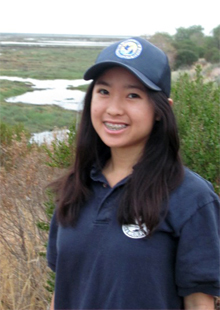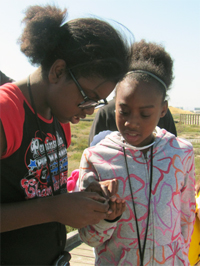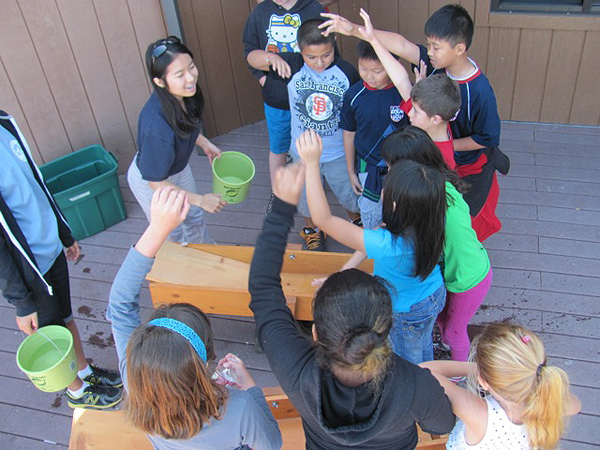
Mission San Jose High School senior Lynnea Shuck was recently honored with a prestigious Brower Youth Award for creating the Junior Refuge Ranger Program at nearby Don Edwards San Francisco Bay National Wildlife Refuge, near her Fremont hometown. Her program provides hand-on learning and activity guides to introduce children from the ages of 8 to 11 to the biological richness of the refuge. Her ultimate goal? To propel children’s natural curiosity into lifelong environmental stewardship.
BN: Are you a Bay Area native?
LS: Yes, I am. I was born and raised in Fremont. My family has lived in California for many generations.
I think the Bay Area is so forward-looking about nature and the environment. I feel blessed to be in a part of the world where sustainability is so important, and I want to bring that to other parts of the US that might not have that yet.
BN: You received the Brower Youth Award for creating the Junior Refuge Ranger Program. Tell us about the program.
LS: It’s an educational program that brings kids to the refuge. They learn about what the refuge is, why we’re here, and some things they can do to make the world a better place. The kids do hands-on things, habitat hikes, learning expeditions, and lab experiments. They learn about endangered species, habitat restoration, and they develop a larger environmental awareness. Kids come away with an appreciation of nature and their role in it.
BN: What are some of the challenges inherent in connecting children with nature today? How does your program address these issues?
LS: I think nowadays, especially being so close to Silicon Valley where we have so much technology, sometimes we lose our most basic connection, our connection to the world around us, to nature.
National wildlife refuges provide an opportunity for us to connect with nature. Our refuges are unique in that their primary purpose is to protect endangered species and the land and habitat they depend upon. The Don Edwards SF Bay Wildlife Refuge protects two species, the Ridgeway rail and the salt marsh harvest mouse, which only live around San Francisco Bay.
BN: How did you first become interested in habitat and species conservation?
LS: My dad is very outdoorsy; he took me all over, going to different parks. I had been coming to the refuge since I was little for different programs. In the seventh grade I started coming to the refuge for the Habitat Hero program, which trains youth leaders. I thought it would be fun to try out. I just loved the program. That’s really when the environment became meaningful to me. I wanted to return and help out.

BN: What kind of educational background and training did you have that prepared you to start the Junior Ranger Program?
LS: I combined the knowledge I had gained from my experiences at the refuge with what I learned in my AP Environmental Science class. I took that class last year as an elective. It was a wonderful class. It helped me see that all of these complicated topics can be made available to any age. It’s all in how you teach it. Sustainability, especially, can be taught to younger students. For many kids this is their first exposure to environmental education, so it’s important they have a well-rounded experience. That means both educating them about issues and problems, and taking it a step further and talking about solutions.
BN: What has been the most challenging aspect of this project?
LS: I struggled at first with how to translate these complicated concepts into something that kids can understand. I concluded that the refuges themselves are the perfect place for this, where kids can see and taste and touch all these things in the real world. Hands-on experience at the refuge is central to the program. It’s one thing to learn about marsh plants in a classroom. It’s another to be standing in the marsh, touching the plants, and even tasting the pickleweed.
I was a kid not too long ago. I thought about myself a couple of years back: How would I wanted to have learned this? I know a lot of people who just learned this stuff from a textbook in a classroom. How can I make this more meaningful, how could I make this more real? What would make sense?
I’ve recently been certified as an interpretive guide. It was a forty-hour workshop through the National Wildlife Refuge, in which we learned about different ways to reach an audience and to explain the mission of the refuge.
BN: What is your long-term goal for the program?
LS: My ultimate vision is to see it expand to each and every one of the 560 wildlife refuges in the United States. It’s not impossible! I’ve created a how-to guide with models and templates so that other refuges can drag and drop their info into it. Already we have about 11 refuges implementing this program. I want to see children visiting all the wildlife refuges learn about all the different habitats and species they are designed to protect.
Personally, I didn’t think about studying environmental science before I came to the refuge, but now I think I could be doing this for the rest of my life. I’d like to study environmental policy, then come back to the refuge and help out.
BN: What is your favorite outdoor destination in the Bay Area?
LS: The Don Edwards San Francisco Bay Wildlife Refuge. It’s just gorgeous. At sunset it’s so beautiful, it’s unreal. Whenever I go there, I come back feeling refreshed and recharged and completely happy.
Lynnea Shuck is one of six recipients of the Earth Island Institute’s prestigious 2014 Brower Youth Awards, which recognize young environmentalists from around the country for their outstanding efforts to promote ecological sustainability and social justice. Watch Lynnea’s BYA Awards video.





